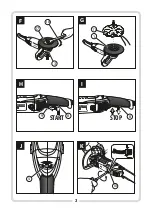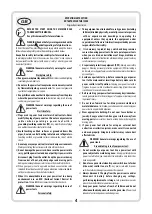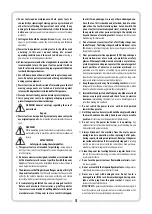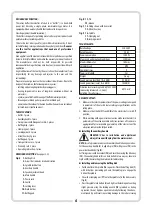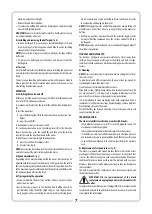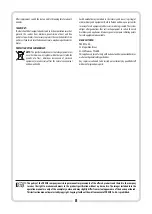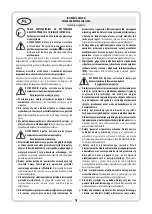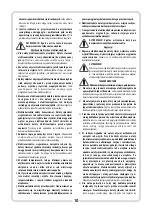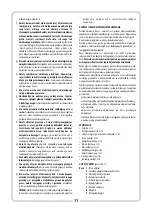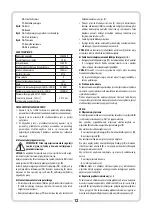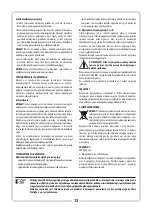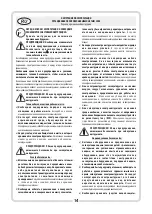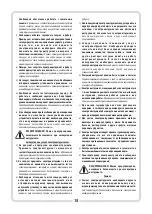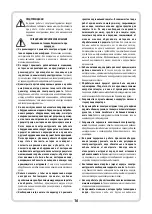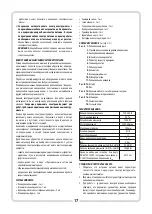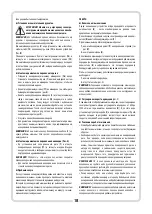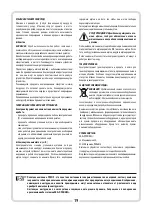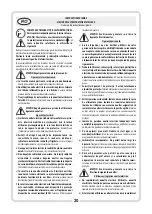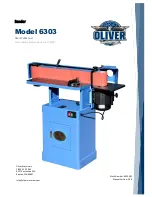
5
e)
Power tools require maintenance. Check power tools for
check it for any damage or use any other undamaged one.
concentricity or jamming of moving parts, any cracks and all
Once the tool bit is checked and attached, stand in
other
plane than the tool bit rotation plane. Set and switch the
other factors affecting the power tool work safety. If any
power tool to its maximum speed (revs), making sure that
damage to the power tool is detected, it should be repaired
the operator and other persons staying in the vicinity are
before use.
Improper power tool maintenance is a reason for many
beyond the zone of rotating tool bit.
Damaged tool bits usually
accidents.
break during this trial period.
f)
Cutting tools should be sharp and clean.
Keeping sharp cutting
e)
Do not leave any loose items, first of all, fixing strings near
edges in good condition reduces the risk of jamming and facilitates
the buffer pad. The fixing strings should be hidden or cut to
operation.
fit.
Any loose, rotating strings may capture your fingers or entangle in
g)
Power tools, equipment, working tools etc. should be used
the object being buffed.
according to this user's manual taking into account
f)
Wear personal protective equipment (PPO). Depending on
operating conditions and the work to be done.
Misusing a
the operation, wear a face mask, eye protection or safety
power tool can result in dangerous situations.
glasses. Where applicable, wear a dust mask, ear protection,
h)
At low temperatures and after a long brakes in operation it is
protective gloves and apron to protect the operator against
recommended to turn the power tool to operate it with no
small particles of abrasive or material machined.
Eye
load for a few minutes to provide proper grease distribution
protection must be capable of catching flying particles generated
inside its driving mechanism.
during various operations. Dust masks and respiratory tract protection
i)
Use soft, damp (cannot be wet) cloth and soap to clean power
should collect dust particles generated during operation. Long-term
tools. Do not use petrol, solvents and other agents that may
exposure to intensive noise can result in hearing loss.
damage your equipment
.
g)
Keep the power cord away from rotating tool bits.
In case of
j)
Power tools can be stored/carried after making sure that all
losing control over the power tool, its power cord can be pulled in, while
moving components are locked and protected against
the palm or the hole hand may get into the rotating tool bit.
release with original devices intended for this purpose.
h)
Immobilize the object to be buffed properly. Make sure its all
k)
Store power tools in a dry, dust and water-protected place.
clamps are properly secured and check for any excessive
l)
Carry your power tool in its original packaging to provide
clearance.
Immobilizing the object in a vice or a clamping device is
protection against mechanical damage.
safer than holding it in your hand.
WARNING! General warnings regarding the use of
i)
Do not switch the power tool on with its disk pointed
power tools.
towards the operator.
j)
Hold the power tool securely with both hands placed behind
Repair
:
the main handle and auxiliary handle and stay in a stable
position.
It is safer to move the power tool with both hands.
k)
Do not carry the power tool when it is operating.
Any
accidental contact of tool bit with clothes may result in pulling it in and
disk contact with operator's body.
l)
Always disconnect the machine from the mains power
during breaks in operation, when replacing buffer pads,
during repairs, cleaning or adjustment. Never put the power
ROTARY BUFFER
tool aside unless its tool bit is completely stopped.
A rotating
Safety tips for using the rotary buffer:
tool bit can come into contact with the surface it has been put down,
a)
This power tool is not intended for polishing.
Using a power
which may result in losing control over the power tool.
tool to perform jobs it is not designed for can be dangerous and may
m)
Clean the power tool venting holes on a regular basis.
Motor
result in injuries.
fan can force dust into the casing, excessive metal dust deposits may
b)
Do not use accessories designed, intended or recommended
result in electric shock.
by the manufacturer for use not specifically with this power
n)
Do not use the power tool near flammable materials.
Sparks
tool.
Even if an accessory can be installed on the power tool, it does not
can cause ignition.
mean it provides safe use or operation.
o)
Do not use tool bits that require liquid coolants.
Using water or
c)
The diameters of buffing disks and flanges must perfectly fit
other liquid coolants may result in electric shock.
the power tool spindle.
Tool bits with openings that do not match
p
)
Never use a tool with damaged cord. Do not touch a
perfectly the spindle diameter, rotate non-uniformly and vibrate
damaged cord; if the cord becomes damaged during work,
intensely, which may result in losing control over the power tool.
take out the plug from the power socket.
Damaged cords
d)
It is absolutely prohibited to use any damaged tool bits.
increase the risk of electric shock.
Before each use check its accessories e.g. buffer pads for
ATTENTION!
If a permanently fixed power cord becomes damaged, it
tears, excessive wear and dirt, buffing disks for cracks, loss of
must be replaced with a special cable or assembly available at the
material or wear. If the power tool or a tool bit is dropped,
manufacturer's or at a specialized repair service po
int.
a)
Power tools can be repaired by competent persons only who
use original spare parts.
It will provide safe operation for the power
tool.
WARNING!
While operating power tools it is necessary to observe basic
work safety rules to avoid fire, electric shock or mechanical
injury.
Summary of Contents for TMA1300K
Page 2: ...2 A 1300W 1 2 3 4 5 7 8 9 10 11 B 12 13 C D 14 14 15 4 15 4 E 17 1 16 13 00 W 6 4...
Page 14: ...RCD TMA1300K 14...
Page 15: ...15 a a...
Page 16: ...16...
Page 19: ...19 n 10 5 7 n K 6 34 03 228 PROFIX...
Page 36: ......



